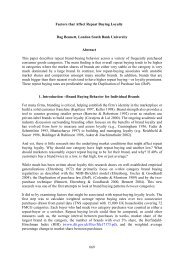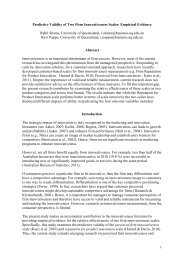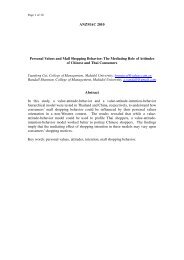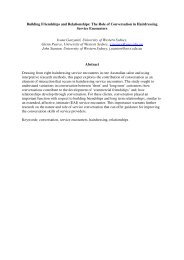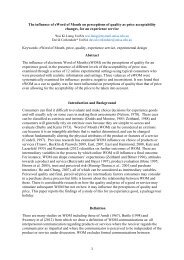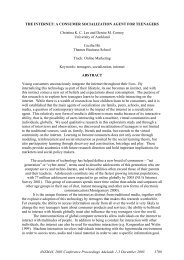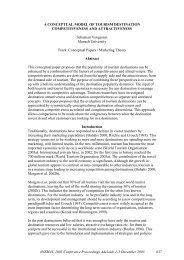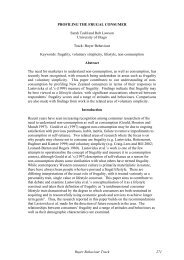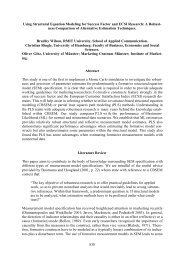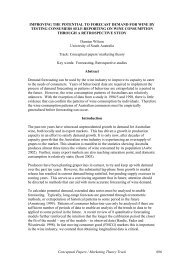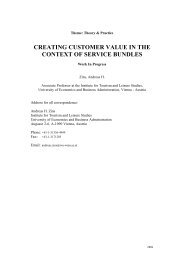Brand Halo: Understanding its Implications ... - ANZMAC
Brand Halo: Understanding its Implications ... - ANZMAC
Brand Halo: Understanding its Implications ... - ANZMAC
Create successful ePaper yourself
Turn your PDF publications into a flip-book with our unique Google optimized e-Paper software.
The phenomenon has further implications as brands are compared to one another. In Figure 1,<br />
the arrow labelled C represents the process that occurs as a new brand enters a consideration<br />
set. At this stage, in a pursuit to maintain coherence in judgement, consumers who favour<br />
Qantas, or simply hold it as a status quo in their decision-making, will modify their<br />
perceptions of attributes to fit their evaluation against a competing company. In the airflight<br />
example, a consumer might shift importance to Qantas’ Flight Frequency, which had not been<br />
prioritized in the decision task until now, and/or construct negative inferences regarding<br />
JetStar’s Flight Frequency, one of the D arrows in Figure 1. Erdem, Swait and Louviere<br />
(2002) show that consumers have different price sensitivities for products with distinct brands<br />
despite their equivalent configurations, which could be a function of different consumer brand<br />
valuation <strong>its</strong>elf, as well as a result of different expected utilities from specific aspects of<br />
products from different brands.<br />
This same process would be complemented by the opposite effects, with JetStar as the focal<br />
brand of analysis. Hence, beliefs regarding attributes and attribute levels of the product<br />
category would mould the attitude towards the brand JetStar. This brand attitude would<br />
feedback into the evaluation process both in regards to <strong>its</strong> own attribute beliefs, but also to the<br />
beliefs of additional brands in the consideration set, in this example Qantas.<br />
Measurement of <strong>Brand</strong> <strong>Halo</strong><br />
The extension of halo effects to brands is a not new concept, with initial steps in the literature<br />
circa 1970s (Bass & Talarzyk, 1972; Bass & Wilkie, 1973; Beckwith & Lehmann, 1975,<br />
1976; Huber & James, 1978; Johansson et al., 1976; Wilkie, McCann, & Reibstein, 1974).<br />
Albeit these studies stressed the value in comprehending this phenomenon with multiattribute<br />
attitudinal models, the operationalization of these proved a more complicated<br />
endeavour, especially in regards to the delineation of this brand halo in a choice context.<br />
Since <strong>its</strong> identification, halo effects have been verified by observance of inter-attribute<br />
correlations of rating data, where factor analysis is used to identify highly related attributes,<br />
characterized by having 0.6-0.7 as a rule of thumb for defining high level of bias in judgement<br />
(Leuthesser et al., 1995; Thorndike, 1920). Wu and Petroshius (1987) mention that the<br />
effectiveness of this alternative rating procedures as a halo reduction tool is elusive, which<br />
receives support from Bagozzi (1996), who distinguishes affective-ignited brand halo from<br />
simple inter-attribute correlations because the latter are an empirical observation that cannot<br />
be objectively be ascertained as a result of the former.<br />
A more refined approach was presented by Russo, Meloy and Medvec (1998), with<br />
experiments designed to investigate the distortion of information in consumer judgment. In<br />
this study, one group received a favourable irrelevant additional piece of information,<br />
prompting positive attitude towards a specific fictitious brand, whereas for another condition<br />
different brands were presented at each choice set, eliminating the possibility of formation of<br />
brand-specific affective response (Russo et al., 1998). Russo, Meloy and Medvec (1998)<br />
stress that understanding distortion of information is particularly important for studies that<br />
rely on conjoint measurement techniques: the increased use of discrete choice experiments<br />
and econometric modelling techniques in the marketing discipline begs for a refinement on<br />
how this phenomenon can be addressed for a utility-model implementation.



